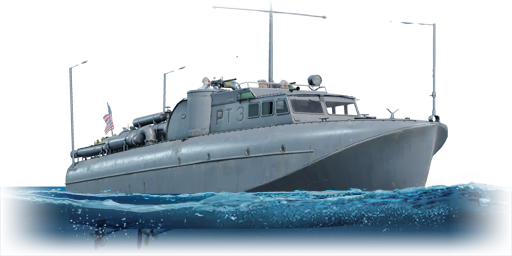



One of a few PT boats surviving to this day, the PT-3 was laid down on 18 April 1940 in Detroit for the United States Navy, Motor Torpedo Boat Squadron 1. In 1942 she was transferred to the Royal Canadian Air Force, designated Bras D'Or (M 413), serving in the rescue duty for the downed airplane pilots. In 1945 she was transferred to US Navy and stricken from the Naval Vessel Register in 1947. Currently it's stored by the Flanigan Brothers Boatyard in Fairton, New Jersey, undergoing restoration.
The PT-3 was introduced in Update 1.83 "Masters of the Sea" as part of the release of fleet into open beta test. It is a premium American motor torpedo boat, making it easier to unlock the boats in rank I and early rank II. Featuring a good survivability and a decent weaponry it's a fair competitor against its peers, but it will struggle to survive against any of the higher Battle Rating vessels.
| Belt | Belt filling | Armor penetration (mm) at a distance: | |||||
|---|---|---|---|---|---|---|---|
| 10 m | 100 m | 500 m | 1000 m | 1500 m | 2000 m | ||
| API-T/AP/HEI/AP | 29 | 27 | 20 | 13 | 9 | 6 | |
| API-T/AP/AP/AP | 29 | 27 | 20 | 13 | 9 | 6 | |
| API-T/API-T/API-T/HEI | 28 | 26 | 20 | 15 | 13 | 11 | |
4 × Mk.6 depth charge






 2 x (15 / 20) %
2 x (15 / 20) % 
 2 x 75 %
2 x 75 % 


Seakeeping | |
|---|---|
Unsinkability | |
|---|---|
Firepower | |
|---|---|